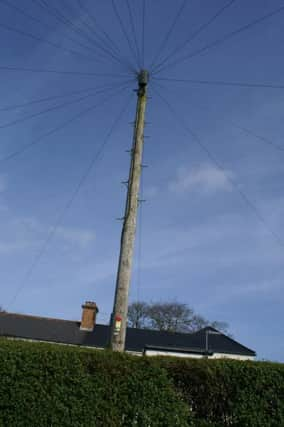Everything you wanted to know about telegraph poles but were afraid to ask


That introductory line here early last month announced the Telegraph Pole Appreciation Society (T.P.A.S), followed by an interview with the organisation’s 56-year-old founder in Wales, Martin Evans.
He was a pole-mine of information, and I’ve been finding out more.
Advertisement
Hide AdAdvertisement
Hide Ad“We get about 10,000 visitors on our website every month,” Martin explained, adding “telegraph pole appreciating can be highly therapeutic, maybe I should start some sort of holistic telegraph pole retreat!”
The UK and Ireland are good locations for poles, but some countries aren’t so well endowed!
Holland is one of the toughest places to find wooden poles. Everything went underground years ago and nothing remains except for high voltage lines.
Just about all of Sweden’s timber poles were taken down in 2007.
Advertisement
Hide AdAdvertisement
Hide AdFrance offers a rich harvest - a lot of the smaller non-electrified railway lines are still lined with wooden poles.
Members of T.P.A.S don’t just cherish the poles, they study, photograph and collect the insulators and the little tin signs and galvanised notifications nailed to the wood.
These artefacts, prized for their age, can be found beside railways tracks and in ditches and hedges around the world.
Such as an old British sign carrying the warning ‘persons throwing stones at the telegraphs will be prosecuted’.
Advertisement
Hide AdAdvertisement
Hide AdIt evidently didn’t deter vandals - the tin sign is peppered with indentations from variously-sized projectiles!
Insulators, generally made of glass or pottery, carry the wires at the top of the poles.
They’re called ‘teleramics’ and come in all sorts of shapes, colours and sizes
They bear intriguing names - shackles, strains, stand-offs and cones - the Fletcher, the Gisborne, the Pothead and the Knob, which originated in India.
Advertisement
Hide AdAdvertisement
Hide Ad“I have a sneaky feeling you’ll no longer be able to pass a telegraph pole without an admiring glance upwards,” Martin told me, suggesting that I should seek out a pole and “celebrate the glorious, everyday mundanity of these simple silent sentinels, and all the things that hang from them, stand on them and nest in them.”
I found one near my home.
Martin divides poles into three main categories - ‘simple’, ‘interesting’ and ‘alluring’.
Mine was ‘simple’, with no insulators, fittings or fixtures at the top, excepting a black box with a thick clutch of protruding wires, and a series of bolted-on foot-irons.
Over 20 telephone wires radiated outwards.
Half a dozen starlings squawked down at me whilst I studied the ‘Telegraph Pole Hieroglyphics’ - the little engravings, plaques and embossed badges, six or seven feet from the ground.
Advertisement
Hide AdAdvertisement
Hide AdThe hieroglyphics don’t easily translate, but include the most recent date of inspection, and the letters ‘DP’ referring to the ‘distribution point’.
Much of it is in code - A1024, HHT, Gnd. Level and OUC-NE 13C.
There are various other technical specifications, serial numbers and data, and even an engineer’s signature, all denoting the age, condition, tree species, wood-type, manufacturer and preservation process of the pole.
New poles don’t need to be tested for the first 12 years and thereafter require testing every 10 years.
Advertisement
Hide AdAdvertisement
Hide AdIf a pole is ‘out-of-test-date’ engineers aren’t allowed to climb it and must use an elevating platform.
Mine is marked 12/16 so it is bang up-to-date.
Martin Evans’s isn’t, and he claims to have instigated “the world’s first ever telegraph pole restoration project.”
His pole comes from a field near to his home at Meifod in Wales.
“I’ve admired it for many years…until recently!” he told me.
Advertisement
Hide AdAdvertisement
Hide AdHe looked out of his window one day and there was an engineer “up a ladder, attending to ‘my’ pole. I didn’t have time to go and pester him as my cat had been sick in the yard and I had to clean it up pronto. But Shock! Horror! When I next looked over, the BT man had gone but so too had the head of my pole. Replaced by a simple, single plastic box!”
Martin was “bereft at such wanton despoliation of our telephonic heritage!”
Fortunately the man from BT didn’t “dispose of the remains properly and had just ‘hoiked’ it over the hedge and into my field where, to my delight, I found it a couple of weeks later among some trees.”
Reunited with his favourite telegraph pole, Martin took it inside “for a cup of tea and the chance to dry out. It was wet, slimy and covered in green algae. It was then that I decided to restore it to its former glory.”
Advertisement
Hide AdAdvertisement
Hide AdThree (beloved) ceramic insulators on the wooden cross-arm required a great deal of conservation work.
“My wife broke one after I had left them in the sink to soak along with the breakfast dishes,” Martin fretted, adding “I have to wonder if she’s as 100% committed to this telegraph pole restoring as I am - she wasn’t even sobbing uncontrollably when she told me!”
I don’t know what sort of tree Roamer’s telegraph pole came from but Martin Evans’ restored pole is Keruing - “a medium hardwood that comes mainly from Malaysia, and must have been harvested by the millions of tons.”
He doesn’t like to think too much about “the forest habitats destroyed and countless monkey evictions all in the name of progress in the western world. Still it is not the fault of the poles themselves, rather the people who sourced them.”